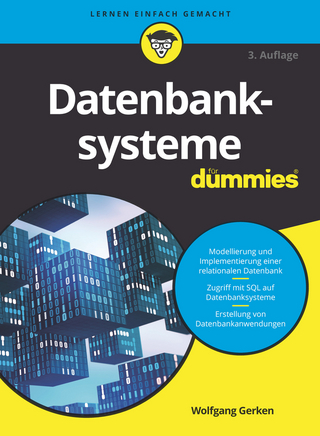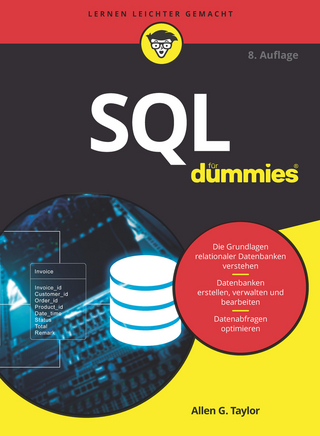
Cluster Analysis and Applications
Springer International Publishing (Verlag)
978-3-030-74554-7 (ISBN)
Suitable for an introductory course on cluster analysis or data mining, with an in-depth mathematical treatment that includes discussions on different measures, primitives (points, lines, etc.) and optimization-based clustering methods, Cluster Analysis and Applications also includes coverage of deep learning based clustering methods.
With clear explanations of ideas and precise definitions of concepts, accompanied by numerous examples and exercises together with Mathematica programs and modules, Cluster Analysis and Applications may be used by students and researchers in various disciplines, working in data analysis or data science.
lt;b>Rudolf Scitovski received his Ph.D. in Applied Mathematics from the University of Zagreb in 1984. He works as a Professor at the Department of Mathematics, University of Osijek. He was the Head of the Department of Mathematics for a long period of time. Before that, he was employed at the Faculty of Electrical Engineering and the Faculty of Economics, University of Osijek. His research interests include least square and least absolute deviations problems, clustering and global optimization.
Kristian Sabo received his Ph.D. in Applied Mathematics from the University of Zagreb in 2007. He works as a Professor at the Department of Mathematics, University of Osijek. His research interests are Applied and Numerical Mathematics (Curve Fitting, Parameter Estimation, Data Cluster Analysis) with applications in Agriculture, Economy, Chemistry, Politics, Electrical Engineering, Medicine, Food Industry, Mechanical Engineering.
Francisco Martínez-Álvarez recevied his Ph.D. in Computer Science from the Pablo de Olavide University in 2010. He works as a Professor at the Department of Computer Science, at the same univeristy. He was the Head of the Department of Computer Science for some years and co-founded the Data Science and Big Data Lab in 2015. He has been a visiting scholar to various universities, such as New York University, Universidad de Chile or Université de Lyon. His research interests include machine learning, optimization, forecasting and big data analytics.
Sime Ungar received his Ph.D. in Topology from the University of Zagreb in 1977. He spent the academic year 1978/79 as a Visiting Assistant Professor at the Department of Mathematics, University of Utah, Salt Lake City, Utah, USA. He worked as a Professor at the Department of Mathematics, University of Zagreb and at the Department of Mathematics, University of Osijek, and is now retired. His research interest is in geometric and algebraic topology, mathematical analysis and inequalities.
1.- Introduction. 2 Representatives.- 2.1 Representative of data sets with one feature. 2.1.1. Best LS-representative.- 2.1.2 Best `1-representative.- 2.1.3 Best representative of weighted data.- 2.1.4 Bregman divergences.- 2.2 Representative of data sets with two features.- 2.2.1 Fermat-Torricelli-Weber problem.- 2.2.2 Centroid of a set in the plane.- 2.2.3 Median of a set in the plane.- 2.2.4 Geometric median of a set in the plane.- 2.3 Representative of data sets with several features.- 2.3.1 Representative of weighted data.- 2.4 Representative of periodic data.- 2.4.1 Representative of data on the unit circle.- 2.4.2 Burn diagram.- 3 Data clustering.- 3.1 Optimal k-partition.- 3.1.1 Minimal distance principle and Voronoi diagram.- 3.1.2 k-means algorithm.- 3.2 Clustering data with one feature.- 3.2.1 Application of the LS-distance-like function.- 3.2.2 The dual problem.- 3.2.3 Least absolute deviation principle.- 3.2.4 Clustering weighted data.- 3.3 Clustering data with two or several features.- 3.3.1 Least squares principle.- 3.3.2 The dual problem.- 3.3.3 Least absolute deviation principle.- 3.4 Objective function F(c1, . . . , ck) = Pm i=1 min 1 j k d(cj , ai).- 4 Searching for an optimal partition.- 4.1 Solving the global optimization problem directly.- 4.2 k-means algorithm II.- 4.2.1 Objective function F using the membership matrix.- 4.2.2 Coordinate Descent Algorithms.- 4.2.3 Standard k-means algorithm.- 4.2.4 k-means algorithm with multiple activations.- 4.3 Incremental algorithm.- 4.4 Hierarchical algorithms.- 4.4.1 Introduction and motivation.- 4.4.2 Applying the Least Squares Principle. 4.5 DBSCAN method.- 4.5.1 Parameters MinPts and 97 4.5.2 DBSCAN algorithm.- 4.5.3 Numerical examples.- 5 Indexes.- 5.1 Choosing a partition with the most appropriate number of clusters.- 5.1.1 Calinski-Harabasz index.- 5.1.2 Davies-Bouldin index.- 5.1.3 Silhouette Width Criterion.- 5.1.4 Dunn index.- 5.2 Comparing two partitions.- 5.2.1 Rand index of two partitions.- 5.2.2 Application of the Hausdorff distance.- 6 Mahalanobis data clustering.- 6.1 Total least squares line in the plane. 6.2 Mahalanobis distance-like function in the plane.- 6.3 Mahalanobis distance induced by a set in the plane.- 6.3.1 Mahalanobis distance induced by a set of points in R n.- 6.4 Methods to search for optimal partition with ellipsoidal clusters.- 6.4.1 Mahalanobis k-means algorithm 139 CONTENTS v.- 6.4.2 Mahalanobis incremental algorithm.- 6.4.3 Expectation Maximization algorithm for Gaussian mixtures.- 6.4.4 Expectation Maximization algorithm for normalized Gaussian mixtures and Mahalanobis k-means algorithm.- 6.5 Choosing partition with the most appropriate number of ellipsoidal clusters.- 7 Fuzzy clustering problem.- 7.1 Determining membership functions and centers.- 7.1.1 Membership functions. 7.1.2 Centers.- 7.2 Searching for an optimal fuzzy partition with spherical clusters.- 7.2.1 Fuzzy c-means algorithm.- 7.2.2 Fuzzy incremental clustering algorithm (FInc).- 7.2.3 Choosing the most appropriate number of clusters.- 7.3 Methods to search for an optimal fuzzy partition with ellipsoidal clusters.- 7.3.1 Gustafson-Kessel c-means algorithm.- 7.3.2 Mahalanobis fuzzy incremental algorithm (MFInc).- 7.3.3 Choosing the most appropriate number of clusters.- 7.4 Fuzzy variant of the Rand index.- 7.4.1 Applications.- 8 Applications.- 8.1 Multiple geometric objects detection problem and applications.- 8.1.1 Multiple circles detection problem.- 8.1.2 Multiple ellipses detection problem.- 8.1.3 Multiple generalized circles detection problem.- 8.1.4 Multiple lines detection problem.- 8.1.5 Solving MGOD-problem by using the RANSAC method.- 8.2 Determining seismic zones in an area.- 8.2.1 Searching for seismic zones.- 8.2.2 The absolute time of an event.- 8.2.3 The analysis of earthquakes in one zone.- 8.2.4 The wider area of the Iberian Peninsula.- 8.2.5 The wider area of the Republic of Croatia.- 8.3 Temperature fluctuations.- 8.3.1 Identifying temperature seasons.- 8.4 Mathematics and politics: How to determine optimal constituencies?.- 8.4.1 Mathematical model and the algorithm.- 8.4.2 Defining constituencies in the Republic of Croatia.- 8.4.3 Optimizing the number of constituencies.- 8.5 Iris.- 8.6 Reproduction of Escherichia coli. 9 Modules and the data sets.- 9.1 Functions.- 9.2 Algorithms.- 9.3 Data generating.- 9.4 Test examples.- 9.5 Data sets.- Bibliography.- Index.
| Erscheinungsdatum | 26.07.2022 |
|---|---|
| Zusatzinfo | X, 271 p. 131 illus., 124 illus. in color. |
| Verlagsort | Cham |
| Sprache | englisch |
| Maße | 155 x 235 mm |
| Gewicht | 437 g |
| Themenwelt | Mathematik / Informatik ► Informatik ► Datenbanken |
| Schlagworte | agglomerative hierarchical clustering • distance-like function • Global Optimization • incremental algorithm • K-means • multiple line detection • optimal partition |
| ISBN-10 | 3-030-74554-6 / 3030745546 |
| ISBN-13 | 978-3-030-74554-7 / 9783030745547 |
| Zustand | Neuware |
| Haben Sie eine Frage zum Produkt? |
aus dem Bereich


